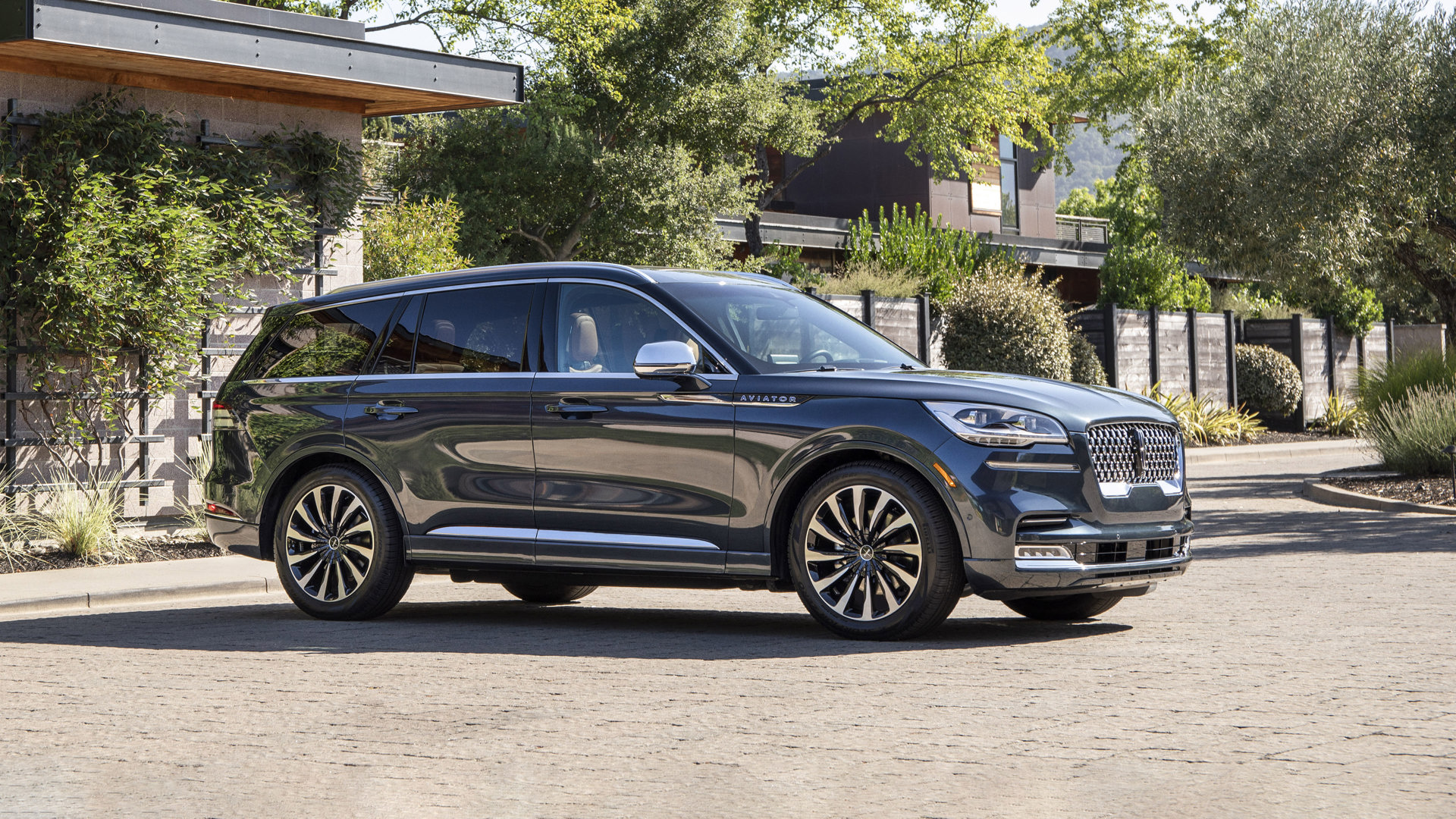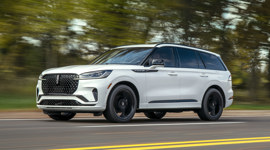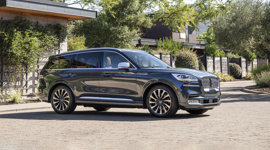There were six finalists in the Luxury 3-Row SUV category, which our team of more than 20 professional automotive reviewers selected after comprehensive, rigorous testing and careful analysis of every vehicle available in the segment. Each of these contenders offers sophisticated engineering, up-to-the minute technology, and room for seven passengers, all wrapped in a premium, luxury package. The finalists our jury voted to advance to the final round of voting were the Mercedes-Benz GLE, Lincoln Navigator, BMW X7, Acura MDX, Audi Q7, and Lincoln Aviator.
But there can only be one winner. After the votes were tallied, the Lincoln Aviator amassed the highest number of points and exhibited all the qualities our judges were looking for in a luxury three-row SUV.
Replacing the MKT in its crossover lineup, the Aviator is a brand-new vehicle for Lincoln, slotting in just below the Navigator and above the Nautilus. Though it’s based on the same platform that underpins the new Ford Explorer, the Aviator boasts a more sophisticated suspension setup, completely different sheetmetal, and a well-crafted cabin replete with a long list of comfort and technology features. The Aviator is the third in a completely revised crossover lineup that’s helped re-establish Lincoln as a luxury brand. As autoTRADER.ca’s own Jeff Wilson noted at the Aviator’s debut, the SUV is helping “pull off what’s shaping up to be one of the greatest comeback stories we’ve seen in the automotive realm.”
Lincoln is up against some heavy hitters in the premium, three-row SUV category, particularly from the Germans, who’ve established a lofty benchmark when it comes to the value of brand cachet. Until very recently, the European vehicles were in a category of their own, with all the other entries operating on a tier below them. Volvo has broken into those ranks to become a top contender in its own right, and now Lincoln appears to be ascending the ladder as well.
Lincoln’s designers have been knocking it out of the park lately and the Aviator doesn’t disappoint. The design theme established by the larger Navigator continues, featuring a long hood and swept-back roofline and the familial Bentley-esque chain-mail grille. It makes an imposing, yet stately impression. According to autoTRADER.ca’s Stephanie Wallcraft, who attended the Aviator’s first drive event, “Lincoln says that its designers, wanting to play on the aviation theme, styled the roof line like a jetliner wing and the massive optional 22-inch wheels like turbines.”
One of the most crucial elements for a winning vehicle in this segment is its interior. Premium buyers are accustomed to paying for a certain level of sophistication – but above all, it must be luxurious and comfortable. The Aviator eschews Lincoln’s formerly dour, plastic aesthetic, and replaces it with oodles of rich leather, open-pore wood, and tasteful brushed metals. The dash is made up of stacked, horizontal planes, finished in contrasting leather and brushed metal trim. An eight-inch tablet-style touchscreen rises from the dash and beneath it a floating centre stack finished in piano black houses the simple knob-controls for climate and sound system. At the top of the console is a strip of gear selection buttons, which clears up space in the centre console for extra cubbies, cupholders, USB ports and wireless charging. Front passengers are suitably coddled by 30-way power seats that not only heat or cool those tired muscles, but offer a soothing massage as well. The middle row has generous head and leg room, with reclining seats that slide fore and aft. Like most of its ilk, the Aviator’s third row is handy in a pinch, but cramped for any extended use by adults. Elevating the sense of occasion is a 28-speaker Revel audio system, and warning chimes produced by the Detroit Symphony Orchestra, a small detail that goes above and beyond the call of duty. Thanks to noise cancellation, firewall sound deadening, and the use of acoustic sandwich front and side glass, the Aviator is quiet and serene on-road.
Price-wise, the Aviator falls in the upper end of the spectrum, starting at $75,000 with a less expensive base model to arrive soon. Luckily, the Aviator feels worth its asking price. It’s currently $10,000 more than the base Audi and Mercedes, and nearly $20,000 more than the Acura. Only the BMW X7 at $93,500, and Lincoln’s own $90,750 Navigator came in higher. Start slathering on the options, and the price tag soars. The arrival of a lower-priced entry-level model will make the Aviator seem like a better value proposition. But the available trim, called “Reserve” comes with a generous features list that makes its price seem more reasonable. Every Aviator comes with Android Auto, Apple CarPlay, on-board Wi-Fi, 20-inch wheels, lane-keeping assist, pre-collision braking, heated and ventilated front and second rows, and heated steering wheel, side mirrors, and wiper blades.
There’s a host of sophisticated options available for the Aviator, including an innovative adaptive cruise control system with speed limit sensing, and the ability to recognize reduced speed zones and reduce speed accordingly. Its tolerance can also be adjusted by drivers who prefer to travel a few kilometres above or below the posted limit. Also notable is the super-crisp head-up display that’s perfectly legible through polarized lenses, and a new Lincoln Way app will let you use your smartphone as a key fob to unlock and start the car. This customizable function lets you program time and limits for valet parking. All Canadian Aviators will come with standard all-wheel drive.
The Aviator offers an impressive list of available features that include an air suspension system that automatically lowers the vehicle by 50 mm to make entry easier, and, using a camera system to scan ahead, can lift at individual corners to lessen pothole impact. Lane centering is another impressive piece of technology that keeps the vehicle in the middle of its lane without the continuous bouncing off the line markers so prevalent in other systems.
There’s one powertrain for now (with a hybrid version to follow) consisting of a 3.0L twin-turbo V6 engine producing 400 hp and 415 lb-ft of torque, mated to a 10-speed automatic transmission that’s operated by a row of console buttons instead of the traditional gear selector. Smooth and powerful, it offers five drive modes: Normal, Comfort, Excite, Slippery, and Deep Conditions, adapting throttle responsive, shift patterns, steering weight and suspension firmness. The official fuel ratings for this powertrain are 13.7/L 100 km city/9.7 highway and 11.9 combined – which puts it mid-pack for fuel consumption in its segment.
The Aviator isn’t the most economical offering in its segment. But it’s a fresh, new offering for the premium three-row SUV segment whose distinctive styling, well-crafted interior, innovative technology, attention to detail, and ability to surprise and delight made a big impression on the autoTRADER.ca Awards judges.







